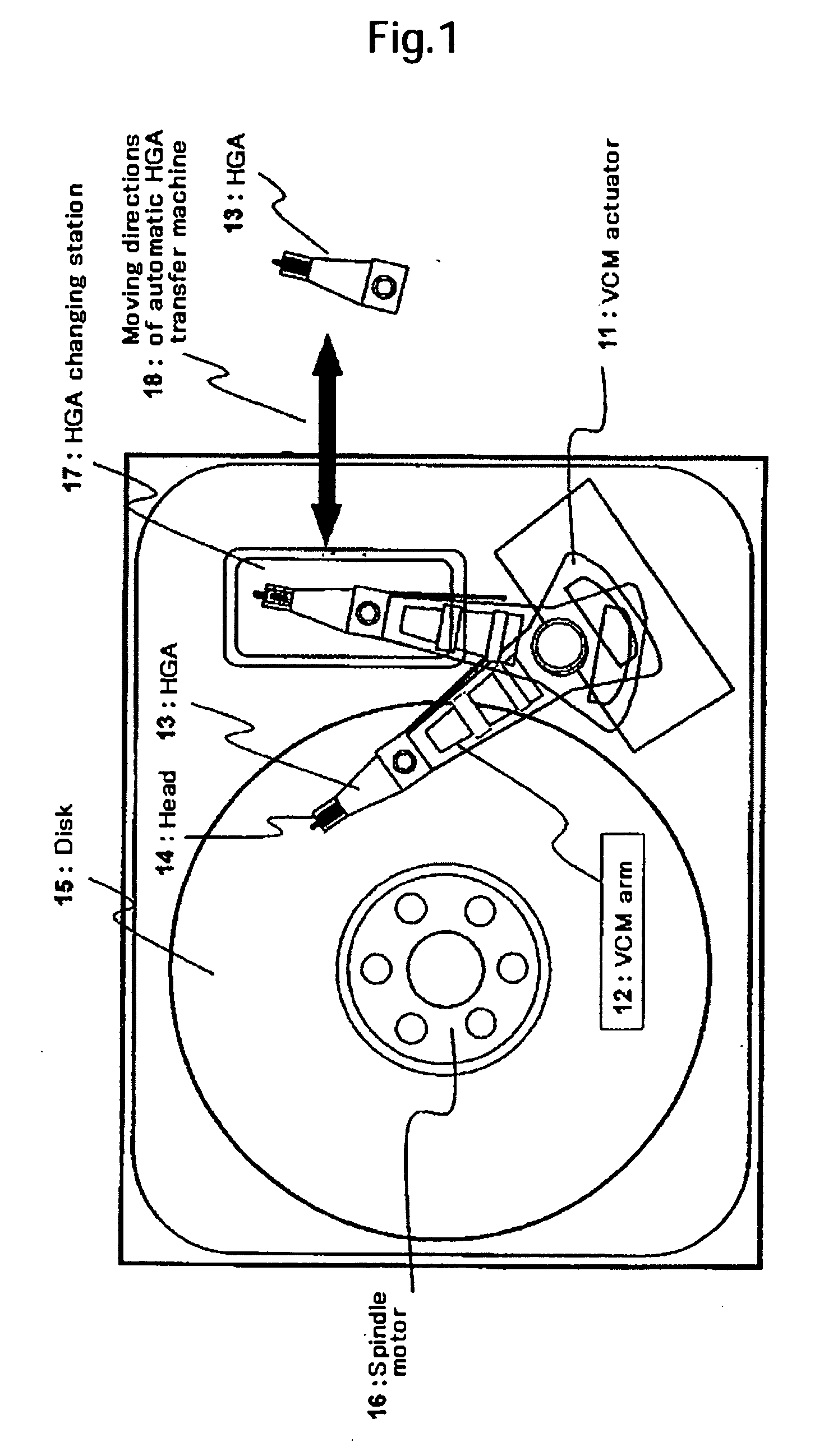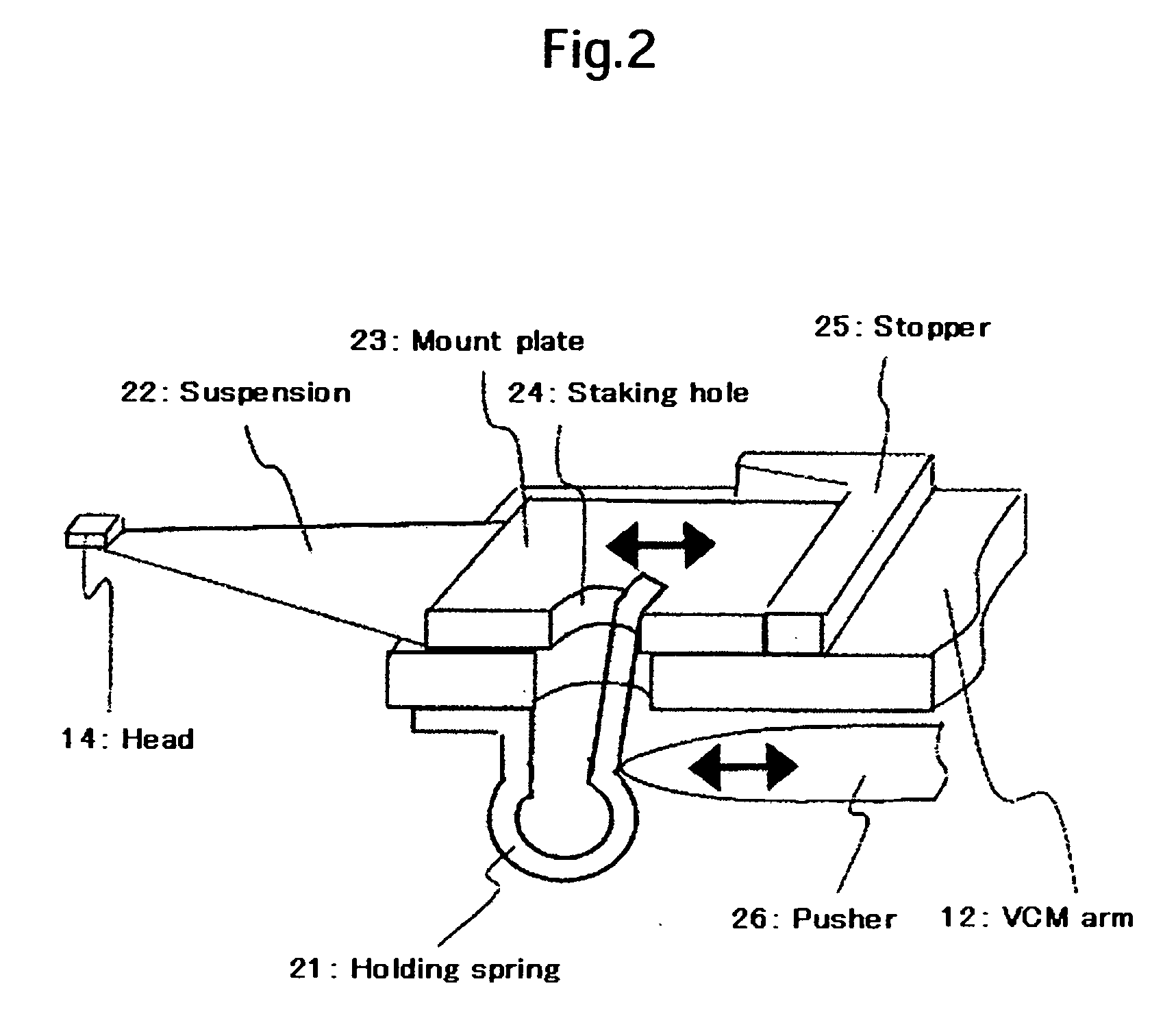Magnetic head tester and method of manufacturing magnetic disk drive
a magnetic disk drive and tester technology, applied in the field of magnetic disk drive manufacturing, can solve the problems of unsolved problems in document 1 such as the magnetic disk testing apparatus, and achieve the effects of accurate servo pattern, small shift of disk center, and small synchronization
- Summary
- Abstract
- Description
- Claims
- Application Information
AI Technical Summary
Benefits of technology
Problems solved by technology
Method used
Image
Examples
embodiment 1
[0029] A magnetic head tester in Embodiment 1 uses a holding spring 21 for holding an HGA in place as shown in FIG. 2. The holding spring 21 has a first end part fixed to a lower part of the VCM arm 12 and a second end part pressed against one side of a staking hole 24 formed in an HGA mount plate 23 included in the HGA. This spring force is applied to the HGA. The holding spring 21 presses the HGA mount plate 23 elastically against a stopper 25. To remove the HGA from the VCM arm 12, a pusher 26 included in the magnetic head tester is brought into engagement with a curved part of the holding spring 21 and pushes the curved part of the holding spring 21 to the left, as viewed in FIG. 2, to separate the second end part of the holding spring 21 from the side of the staking hole 24. The HGA thus released from the holding spring 21 can be attached to and removed from the VCM arm 12 by a simple pick & place operation.
[0030]FIG. 3 shows an HGA positioning structure. The HGA is positioned...
embodiment 2
[0032]FIG. 5 shows an HGA fixing mechanism that uses air pressure for fixing the HGA to the VCM arm 12 by way of example. FIGS. 5(a) and 5(b) show the HGA fixing mechanism in an HGA releasing condition and in an HGA fixing condition, respectively. In the HGA releasing condition, an air cylinder actuator 32 pushes up a clamping arm 31 to extend the clamping arm 31. The outside diameter of the thus extended clamping arm 31 is smaller than the diameter of the staking hole 24 formed in the mount plate 23. Therefore, the clamp plate 23 of the HGA can be removed from the extended clamping arm 31 by a pick & place operation. In the HGA fixing condition shown in FIG. 5(b), the air cylinder actuator 32 pulls down the clamping arm 31 so that lower arm members of the clamping arm 31 press the mount plate 23 against the VCM arm 12.
embodiment 3
[0033]FIG. 6 shows another HGA fixing mechanism in Embodiment 3 that uses air pressure for fixing the HGA to the VCM arm 12. FIGS. 6(a) and 6(b) show the HGA fixing mechanism in an HGA releasing condition and in an HGA fixing condition, respectively. This HGA fixing mechanism includes a clamping spring 41 instead of the clamping arm 31. Although this HGA fixing mechanism in Embodiment 3 is substantially the same as the HGA fixing mechanism in Embodiment 2 in the principle of operation, the clamping spring 41 is a single member while the clamping arm 31 has the four arm members. Thus, the HGA fixing mechanism in Embodiment 3 is very simple in construction.
PUM
 Login to View More
Login to View More Abstract
Description
Claims
Application Information
 Login to View More
Login to View More - R&D
- Intellectual Property
- Life Sciences
- Materials
- Tech Scout
- Unparalleled Data Quality
- Higher Quality Content
- 60% Fewer Hallucinations
Browse by: Latest US Patents, China's latest patents, Technical Efficacy Thesaurus, Application Domain, Technology Topic, Popular Technical Reports.
© 2025 PatSnap. All rights reserved.Legal|Privacy policy|Modern Slavery Act Transparency Statement|Sitemap|About US| Contact US: help@patsnap.com



